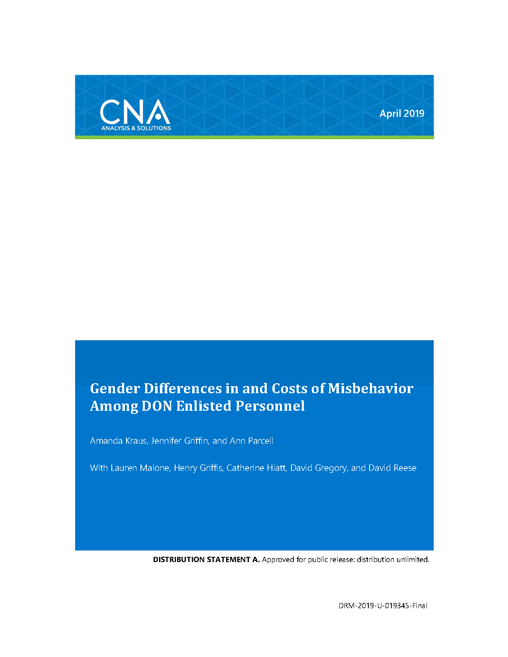In March 2018, the President’s Budget request for the Department of the Navy (DON) for fiscal year (FY) 2019 was $203.2 billion. Of that total, $47.5 billion was requested for the active duty portions of the US Navy (USN) and US Marine Corps (USMC) military personnel (MP) accounts. Despite the size of both the total DON budget and the MP account requests, the increase in demand for USN and USMC forward presence, improved readiness, and lethality continues to put pressure on the DON to operate more efficiently and effectively.
At the same time, the DON seeks to maintain, and perhaps even increase, female representation among uniformed personnel across all paygrades and military occupations. The DON’s goals for more efficiency and effectiveness and for gender integration naturally give rise to a discussion about the costs and benefits of increased female representation. To that end, the Assistant Secretary of the Navy (Financial Management and Comptroller) (ASN(FM&C)) asked CNA to examine the costs and benefits associated with greater gender integration and to assess the potential impact on DON personnel budgets and manning.
Background and motivation
Discussions about increasing the female share of DON uniformed personnel have typically focused on expected costs. For example, previous analyses have focused on the cost and manning implications of lower female retention. Pregnancy has also been a focal point in terms of both the limitations it places on operational assignment and the medical and convalescence costs it imposes.
It is entirely appropriate—even necessary—for the DON to include the costs associated with gender differences in retention and with pregnancy when preparing budgets and projecting manning rates. A comprehensive assessment, however, should also take into account potential benefits of gender integration that may offset these costs. In particular, the DON should consider costs that may be disproportionately associated with the men who make up the majority of the force. For example, several studies have shown that male servicemembers are more likely than female servicemembers to engage in various types of misbehavior including being involved in drug- and alcohol-related incidents and committing certain kinds of crimes. Such misbehavior in the military workplace can be quite costly and can lower productivity. Costs may be incurred by victims, through investigating and adjudicating the misbehavior, through lost workdays and employee dismissal due to misbehavior, and by leaders who must address misbehavior rather than engage in other productive activities. In addition, resources for prevention and response are less likely to be allocated efficiently and effectively if the costs of misbehavior are poorly understood. To our knowledge, however, gender differences in misbehavior rates—and the costs associated with misbehavior—have not been systematically studied in the USN and USMC.
The goal of this analysis is twofold. First, it is intended to support efforts to provide a comprehensive assessment of the costs and benefits of increasing gender integration. Second, it aims to provide the DON with more information about the costs of misbehavior so that resources for prevention and response can be allocated as effectively and efficiently as possible.
Defining and measuring misbehavior
We define misbehavior as offenses covered by the punitive articles of the Uniform Code of Military Justice (UCMJ). As such, misbehavior can range from minor disciplinary infractions to serious criminal offenses. Service responses to misbehavior range from actions that are administrative to actions that are punitive and/or judicial. Based on this definition, we measure misbehavior by certain events recorded in enlisted personnel records. Specifically, for Sailors, we use placement in a disciplinary status, demotions, and misconduct-related separations as indicators of misbehavior. For Marines, we use nonjudicial punishments (NJPs), courts-martial, demotions, and misconduct-related separations. Our measures likely undercount misbehavior incidents because personnel records do not contain such information as conduct resulting in an unofficial reprimand.
With the understanding that our measure is a conservative lower bound, we compute misbehavior rates by gender using these observable personnel record indicators and find that DON active duty enlisted men had higher rates of misbehavior than women in every year between FY 1999 and FY 2015. Depending on the specific indicator of misbehavior and the service, male misbehavior rates were, on average, 1.5 to 2.5 times higher than female rates. Using data from FY 2015 and applying the female misbehavior rates to the male population, we further estimate that the higher rates of male misbehavior generated about 1,400 extra misbehavior incidents in the USMC and about 2,000 extra incidents of misbehavior in the USN.
Download reportDISTRIBUTION STATEMENT A. Approved for public release: distribution unlimited. Specific Authority. To protect information not specifically included in the above reasons and discussions but which requires protection in accordance with valid documented authority such as Executive Orders, classification guidelines, DoD or DoD-component regulatory documents. 4/19/2019
Details
- Pages: 90
- Document Number: DRM-2019-U-019345-Final
- Publication Date: 5/19/2019
